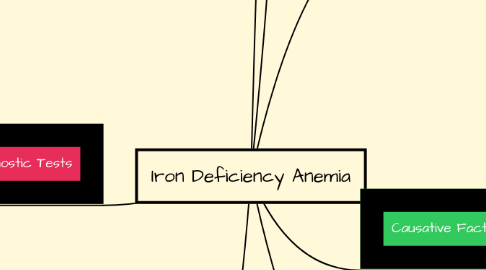
1. Common Findings
1.1. 1. weakness
1.1.1. Text book, exercises 34, 35, 36, 37
1.2. 2. fatigue
1.3. 3. difficulty in concentrating
1.4. 4. poor work productivity
1.5. 5. impaired growth
1.6. 6. impaired cognitive ability
1.7. 7. impaired immune function and resistance to infection
1.8. 8. shortness of breath, dizziness, headaches
1.9. 9. unusual cravings-such as ice, dirt or starch
2. Diagnostic Tests
2.1. 1. transferrin saturation level- of < 16%
2.1.1. New vocabulary
2.1.2. indicates and iron supply that is insufficient to support normal erythropoeisis
2.2. 2. Serrum Ferritin levels
2.2.1. <30 ug/per liter-levels are lower in patients with iron deficiency anemia
2.2.1.1. low levels usually indicate low levels of stored iron
2.3. 3. hemoglobin
2.3.1. with IDA-red blood cells are smaller and paler in color than normal
2.4. 4.hematocrit
2.4.1. percentage of blood volume
2.5. 5. endoscopy
2.5.1. check for bleeding
2.6. 6. colonoscopy
2.6.1. rule out intestinal sources of bleeding
2.7. 7. ultrasound
2.7.1. Women have these to check for fibroids which may cause excess blodd loss.
3. Risk Factors
3.1. 1Being a child under 5, females of childbearing age, and pregnant women
3.1.1. Research and prepare experiment
3.2. 2.vegetarian diets
3.3. 3.Poverty, Malnutrition
3.4. 4. Being a Hemodialysis patient-
3.5. 5. Having a disorder of the GI tract
3.6. 6. pregnancy
4. Pathophysiologic Etiology
4.1. 1. Mechanisis of iron aquisition is tightly regulated by hepcodin-based homeostatic controls.
4.1.1. hepcidin-liver peptide hormone that is synthesized primarily in the liver.
4.2. 2. its prodiction is inhibited by the expansion of erythropoesis, iron deficiency, and tissue hypoxia in response to signals....
4.2.1. signals are in bone marrow, liver, muscle tissue, and adipocytes
4.3. 3..Increases in hepcidin levels that are induced by inflamatory cytokines (interleukin), explain the iron sequestration and reduced supply of erythropoetic iron that occurs in the anemia of chronic disease.
4.4. 4. fluctuations in hepcidin levels have a strong direct correlation with serum levels of ferritin. In iron deficiency, the transcription of hepcidin is suppressed. This adaptive mechanism facilitates the absorption of iron and the release of iron from body stores. Intestinal iron uptake from the gut lumen through divalent metal transporter 1 (DMT1) is increased by the activation of hypoxia-inducible factor. The degree of store repletion determines the rapidity with which iron deficiency develops in cases of blood loss or a drastic reduction in iron absorption.
5. Causative Factors
5.1. 1.insufficient dietary intake of iron
5.1.1. Midterm
5.2. 2.loss of blood
5.3. 3.some infections such as hookworm and schistosomiasis-chronic blood loss
5.4. 4.Heavy Menstrual Bleeding in women or young girls
5.5. 5. Malabsorption
5.6. 6.Blood loss from the GI tract
5.6.1. mostly found in males and elderly patients
6. Treatments
6.1. 1. Iron SUpplementation
6.1.1. Oral iron sulfate
6.2. 2. IV iron infusion
6.3. 3.red cell transfusion
6.3.1. one unit of PRBC contains approx 200 mg of iron
6.4. 4. fix the cause of anemia
6.5. 5. Iron rich foods
6.5.1. broccoli
6.5.1.1. grapefruit
6.5.1.1.1. kiwi
6.5.2. vitamin C helps in the absorption of iron
